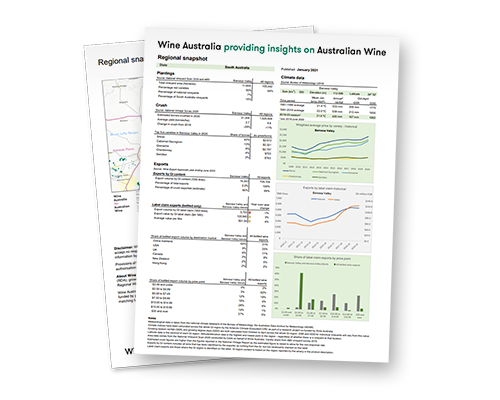Goulburn Valley
The Goulburn Valley wine region is located in Victoria, north of Melbourne. The region is distinctly warm, with a typical inland valley-floor climate and substantial diurnal temperature ranges. The heat is mitigated by the abundance of lakes, billabongs and creeks associated with the Goulburn River
The GI is 9,785 km2 in size and has a total of 1,263 hectares of vineyards. The main varieties grown in the region are Shiraz, Chardonnay, Cabernet Sauvignon, and Merlot.

Goulburn Valley Regional Snapshot 2024-25
Regional Snapshots are one-page profiles updated annually of individual Australian wine regions. They provide at-a-glance summary statistics on: climatic characteristics, viticulture data, winegrape production, and winegrape price and export sales data for wine, compared against the same statistics for the whole of Australia.
Download nowCabernet Sauvignon
Cabernet Sauvignon grew in importance to the region as the variety become more popular in the 1970s and 1980s. Today virtually all wineries, large and small, produce a style that has ripe, warm, earthy, chocolate-accented flavours.
Chardonnay
This is a wine of rapidly increasing importance which flourishes in the region. Chardonnay is capable of producing good yields at high sugar levels, with a peachy, buttery richness attesting to the climate. Instead of being a fast developing wine, in this region Chardonnay has the ability to develop complexity and richness with age.
Marsanne
The Goulburn Valley boasts the oldest and largest plantings of Marsanne in the world. Lemon-accented, the oaked styles gain intensity and richness with age. Unoaked, the wine is delicate in its youth and can be long-lived. As these wines age, they build the honeysuckle bouquet and taste that typifies the variety.
Riesling
Despite being a region with a warmer climate, the region can produce excellent Riesling. The wines have considerable weight, with lime and tropical fruit aromas and flavours. Despite their early appeal, the wines also have the capacity to age attractively over the medium term.
Shiraz
The principal grape grown in the Goulburn Valley for over a century, Shiraz remains capable of producing a red wine of great flavour and longevity. The wines present ripe, rich fruit overtones when young and age to reveal darker fruits, with hints of pepper, dark chocolate, soft supple leather and earth.

- The region is distinctly warm, with a typical inland valley-floor climate and substantial diurnal temperature ranges.
- The heat is mitigated by the abundance of lakes, billabongs and creeks associated with the Goulburn River.
- Abundant water for irrigation and loose textured sandy, gravelly soils typically produce generous yields without compromising colour or flavour.

- The soils vary widely, falling into three principal groups. There are the usual red and brown sandy clay loams of south-eastern Australia, plus yellow-brown clay loams and gritty, gravelly quartzose sands laid down by the Goulburn River.